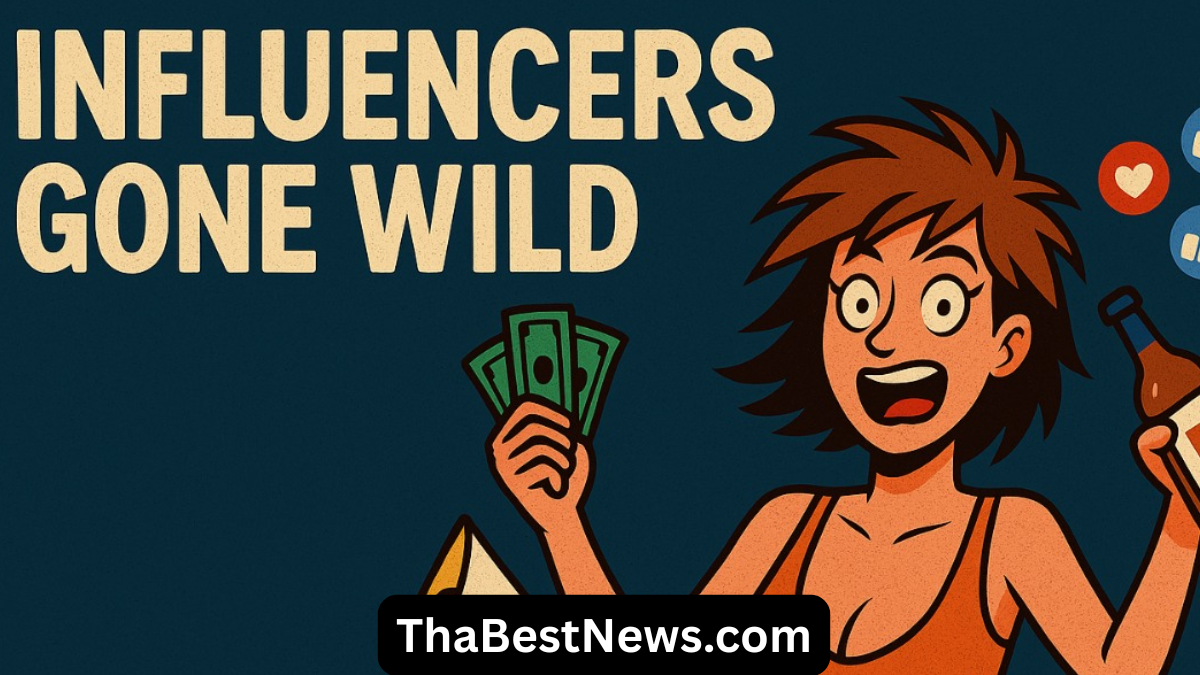Influemcers Gonewild In recent years, the rise of social media influencers has transformed how we consume content, interact with brands, and even perceive celebrity culture. Influencers, individuals who have amassed large followings on platforms like Instagram, TikTok, YouTube, and Twitter, wield tremendous power in shaping trends and opinions. However, this power is often a double-edged sword. The phrase “influencers gone wild” captures a fascinating and sometimes alarming phenomenon where influencers push boundaries, create controversial content, or engage in unpredictable behavior that shocks their audiences and stirs public debate.
This article explores the multifaceted world of influencers gone wild, examining the factors that lead to such behavior, the consequences on their careers and followers, and what it reveals about the culture of fame in the digital age.
The Rise of the Influencer Culture
Before diving into the “Influemcers Gonewild” aspect, it is important to understand the rise of influencers themselves. Influencers began as niche content creators who shared passions—fashion, fitness, gaming, travel, or beauty—and gradually built loyal audiences. Over time, brands recognized their marketing potential and partnered with influencers to reach targeted demographics with authentic, relatable content.
Unlike traditional celebrities, influencers seem more accessible. They share personal glimpses into their lives, creating a sense of intimacy and trust. This accessibility, however, also places them under constant scrutiny. Their every move is public, and followers expect both entertainment and authenticity. The pressure to stay relevant, combined with the allure of fame and fortune, sometimes pushes influencers to “go wild” in unexpected ways.
What Does “Gone Wild” Really Mean?
The phrase “gone wild” typically refers to behavior that is out of the ordinary, provocative, or rebellious. For influencers, this can manifest in several forms. It might mean posting risqué or explicit content that shocks audiences, engaging in public controversies or feuds, experimenting with radical lifestyle choices, or creating viral stunts designed to grab attention. Sometimes, influencers may cross ethical or legal boundaries in pursuit of views, likes, or media coverage.
The motivation behind such behavior often lies in the intense competition on social media. With algorithms favoring sensational or highly engaging content, influencers may feel compelled to push limits to maintain or grow their follower base. For some, going wild becomes a strategy to stay in the spotlight, while for others, it is a form of self-expression or rebellion against industry norms.
Social Media Platforms and the Wild West Mentality
Social media platforms have played a crucial role in shaping this phenomenon. The early days of Instagram, TikTok, and Snapchat were marked by a free-spirited and unregulated environment. The relative lack of strict content moderation allowed influencers to experiment boldly. Even as platforms have implemented guidelines and censorship policies, the rapid pace of content creation means that wild behavior can quickly go viral before being removed.
This environment resembles a digital “Wild West,” where rules are still evolving and influencers navigate gray areas. The desire for virality incentivizes risky behavior. For instance, some influencers have staged controversial pranks, engaged in offensive humor, or shared explicit material under the guise of artistic freedom or shock value.
Examples of Influencers Gone Wild
While many influencers maintain professionalism and positive engagement, some become infamous for their wild antics. Some have posted provocative photos or videos that blur the lines between art and explicit content, challenging societal taboos. Others have been involved in public meltdowns, substance abuse scandals, or legal issues that dominate headlines.
In some cases, influencers have used wild behavior to raise awareness about social issues, intentionally courting controversy to provoke discussion. However, the majority of instances involve attempts to boost personal fame or monetize shock value, which sometimes backfires, leading to bans, loss of sponsorships, or public backlash.
Psychological and Sociological Factors
The phenomenon of influencers gone wild also has roots in psychology and sociology. Influencers often experience pressure to maintain a perfect image while simultaneously being authentic and relatable. This tension can cause stress and identity struggles, leading some to rebel or adopt exaggerated personas to cope.
The concept of “attention economy” plays a significant role. Followers’ attention is the currency of social media success, and capturing it requires ever more creative or extreme content. Peer influence within influencer communities can also encourage wild behavior, as creators try to outdo each other.
From a sociological perspective, this behavior reflects broader cultural trends toward sensationalism and performative identity. The line between genuine self-expression and performance becomes blurred in the influencer space, making it difficult to separate real personality from online persona.
Consequences for Influencers and Their Audiences
The repercussions of going wild are mixed. Some influencers successfully leverage controversy to build a stronger, if more polarized, fan base. Others suffer reputational damage, loss of partnerships, or even legal consequences. Platforms may suspend or ban accounts that violate policies, cutting off influencers from their income streams.
For audiences, influencers gone wild can be both captivating and troubling. While some followers enjoy the entertainment value, others feel alienated or disappointed when influencers cross ethical boundaries. Young or impressionable followers may mimic reckless behavior, raising concerns about the influence of such content on mental health and social norms.
Brand Partnerships and the Challenge of Wild Influencers
Brands have a complicated relationship with influencers who go wild. On one hand, the buzz generated by controversial content can increase visibility and engagement. On the other hand, brands risk association with negative publicity or behaviors that clash with their values.
As a result, many companies implement strict vetting processes and clauses in contracts to mitigate risks. Some brands have even cut ties with influencers whose wild actions have sparked public outrage. This dynamic forces influencers to balance their creative freedom with professional responsibilities.
The Role of Authenticity and Transparency
Authenticity remains a core value in influencer culture. While going wild can sometimes enhance an influencer’s authenticity by showcasing unfiltered behavior, it can also appear as a calculated stunt. Followers are increasingly savvy and can detect inauthentic or manipulative content.
Transparency about motives and boundaries can help influencers maintain trust. Those who openly discuss their struggles or reasons for pushing limits often receive more empathy than those who rely purely on shock value.
Legal and Ethical Considerations
With influencers pushing the envelope, legal and ethical issues come to the forefront. Content involving explicit material, dangerous stunts, or misinformation can violate platform rules or local laws. Influencers may face lawsuits, fines, or bans.
Ethically, influencers have a responsibility toward their audiences, especially minors. The promotion of harmful behavior, exploitation of vulnerabilities, or spreading of false information raises serious concerns about accountability in digital spaces.
The Future of Influencers Gone Wild
Looking ahead, the phenomenon of influencers gone wild will likely continue to evolve. As platforms improve content moderation and society debates the limits of free expression, influencers must adapt. Emerging trends in virtual influencers, AI-driven content, and new platforms will add layers of complexity.
At the same time, audiences may demand higher standards of responsibility and authenticity, pushing influencers toward more meaningful engagement rather than mere sensationalism.
Conclusion: Understanding the Complexity
Influencers gone wild is not a simple story of reckless behavior or fame-hungry stunts. It is a complex interplay of psychological, social, technological, and economic factors. The rise of influencers has created a new type of celebrity whose power is both exhilarating and precarious. The wild moments, while often controversial, also reveal deeper truths about identity, culture, and the shifting landscape of fame in the digital era.
For audiences, brands, and Influemcers Gonewild themselves, understanding these dynamics is crucial for navigating this vibrant and sometimes volatile world responsibly.
Frequently Asked Questions (FAQs)
Q: What does “influencers gone wild” mean?
A: It refers to social media influencers engaging in unexpected, provocative, or controversial behavior that deviates from norms and often garners public attention or shock.
Q: Why do some influencers go wild?
A: Influencers may go wild to stand out in a crowded market, gain more followers, express themselves freely, or react to the pressures of constant visibility and competition.
Q: Are all influencers who post wild content doing it for attention?
A: Not necessarily. While attention is a common motivator, some Influemcers Gonewild genuinely explore creative or personal boundaries, though others use shock tactics strategically.
Q: What impact does wild influencer behavior have on their followers?
A: It can influence follower behavior positively or negatively, sometimes encouraging risky or harmful actions, but also sparking conversations about important issues.
Q: How do brands handle influencers who go wild?
A: Brands typically monitor influencer behavior closely, enforce contracts with conduct clauses, and may sever ties if the influencer’s actions risk damaging their reputation.
Q: Can influencers face legal issues for going wild?
A: Yes, especially if their content violates laws regarding explicit material, dangerous conduct, defamation, or misinformation.
Q: How can influencers maintain authenticity without going wild?
A: By being transparent, honest, and engaging meaningfully with their audience, influencers can build trust without relying on extreme behavior.
Q: Will influencers gone wild continue to be a trend?
A: It’s likely the phenomenon will persist but evolve as platforms, audiences, and regulations change, encouraging more responsible yet creative content.


